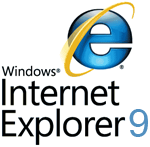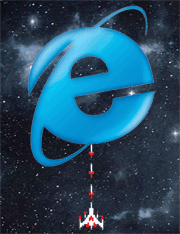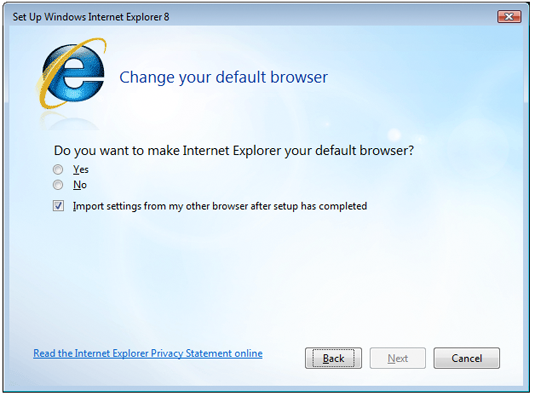I tend to agree with Jason Cross’s contention that Microsoft’s browser would benefit from a reboot, not an update, and I like his proposals for doing so. (For the record, though, Ford is still flogging the Taurus–in fact, it tried to do away with it and then brought it back. Which is a sobering case study in how hard it is to reboot a venerable, pervasive brand.)
Tag Archives | Microsoft Internet Explorer
Which Browser Would You Vote For?
 More news about monopolies and governmental action against them: The European Union has ended its antitrust case against Microsoft over Internet Explorer after Microsoft agreed to give European Windows users a ballot screen which will let them choose between IE and eleven (!) other browsers.
More news about monopolies and governmental action against them: The European Union has ended its antitrust case against Microsoft over Internet Explorer after Microsoft agreed to give European Windows users a ballot screen which will let them choose between IE and eleven (!) other browsers.
A hundred million Europeans will get this feature next year, and at least a few of them are reading this post. But even if you’ve never set foot in an EU country, how about taking this quick poll? The browsers listed are the ones that Microsoft will offer when the ballot screen rolls out.
9 comments
Thoroughly Modern IE9?
 As expected, Microsoft began talking about Internet Explorer 9 in public yesterday at its PDC event in Los Angeles. So far, it’s only talking about its guts–but it’s working on two of the items from my personal IE9 wishlist, faster JavaScript and the beginnings of HTML5 support. Microsoft browser honcho, Dean Hachamovitch, has a blog post up in which he talks about what this means for developers. (It’s a nicely straightforward one, with a chart that shows just how slow IE8’s JavaScript is compared to the competition, and which even discloses that Microsoft has only succeeded in getting IE9 back in the pack so far–it’s still the slowest, but by a lot less.)
As expected, Microsoft began talking about Internet Explorer 9 in public yesterday at its PDC event in Los Angeles. So far, it’s only talking about its guts–but it’s working on two of the items from my personal IE9 wishlist, faster JavaScript and the beginnings of HTML5 support. Microsoft browser honcho, Dean Hachamovitch, has a blog post up in which he talks about what this means for developers. (It’s a nicely straightforward one, with a chart that shows just how slow IE8’s JavaScript is compared to the competition, and which even discloses that Microsoft has only succeeded in getting IE9 back in the pack so far–it’s still the slowest, but by a lot less.)
Hachamovitch also says that IE9 will utilize hardware acceleration to render graphically-rich sites faster and better. Sounds like a good idea, and like an example of Microsoft attempting to make the fact that IE only runs on Windows into an asset rather than a liability. (Browsers that run on multiple platforms are presumably less likely to get a thorough tweaking to run especially well on one particular OS.)
Still no word on what the company is thinking about interface changes, or when it intends to release the browser. I’m still rooting for a major facelift, but we’ll see…
No comments
Here’s My Internet Explorer 9 Wish List. What’s on Yours?
 According to Neowin’s Tom Warren and Cnet News’s Ina Fried, Microsoft will have something–maybe just a little something, but something–to say about its plans for Internet Explorer 9 at its Professional Developers’ Conference in Los Angeles tomorrow. The company often briefs tech reporters in advance about major announcements, but it hasn’t told me a darn thing about IE9. So I’m just as curious as anyone else to know what the upgrade is going to involve.
According to Neowin’s Tom Warren and Cnet News’s Ina Fried, Microsoft will have something–maybe just a little something, but something–to say about its plans for Internet Explorer 9 at its Professional Developers’ Conference in Los Angeles tomorrow. The company often briefs tech reporters in advance about major announcements, but it hasn’t told me a darn thing about IE9. So I’m just as curious as anyone else to know what the upgrade is going to involve.
And for the next few hours, at least, I’m free to ponder the features that would get me excited about a new browser from Microsoft…
22 comments
Internet Explorer’s New Spokesperson
Now, this is an IE ad that’s entertaining rather than repulsive–and probably a smart choice of an endorser of interest to the sort of folks who IE8 and its Web Slices feature will appeal to the most.
Kinda reminds me of when Microsoft dragged out Queen Latifah to pal around with Bill Gates at a Windows Media Center event and neither of them seemed to have a clue what she was doing there–except this time, Dolly seems to be in on the fun.
(Via ReadWriteWeb)
2 comments
Google Burrows into Internet Explorer
 Today, Google announced a plug-in for Internet Explorer that usurps the IE browsing engine’s role, rendering pages with Google Chrome instead. The plug-in, called Google Chrome Frame, targets Web developers who must program around IE 6’s proprietary quirks.
Today, Google announced a plug-in for Internet Explorer that usurps the IE browsing engine’s role, rendering pages with Google Chrome instead. The plug-in, called Google Chrome Frame, targets Web developers who must program around IE 6’s proprietary quirks.
Internet Explorer remains the world’s dominant Web browser, but many of its users are running archaic versions of the software –to the frustration of Microsoft and its critics alike. Older versions of the browser do not support the latest standards, hindering what users can do on the Web.
Google argues that Chrome’s Webkit and JavaScript engines will seamlessly bring IE up to par, awhile preserving the interface that people are accustomed to in IE 6 and IE 7. Microsoft has largely solved its issues with standards support with IE 8, but Google Frame targets it as well.
Of course people will have to install the plug-in, which requires a 10MB download. Web developers will also have to modify their HTML code to invoke the plug-in. Nonetheless, it’s a new approach to getting people to upgrade their browsers.
Google is using an attrition strategy to bring IE users on board with Chrome. I could not imagine why any corporate IT folks would install this plug-in; they keep IE installed for compatibility reasons. Microsoft has also enabled legacy support in IE 8.
Google Chrome Frame is a neat technology, but I don’t expect that your mother will end up using it unless it is bundled with software that people widely use. Google might attempt to leverage its Web properties, but many people are a creature of habit. My father is still using AOL, and my attempt to move him to Gmail failed.
One comment
Should Microsoft Kill IE6?
 A few weeks ago, a blog post at Digg talked about Internet Explorer 6, the challenges Web sites have in continuing to support it, and the declining-but-still-meaningful percentage of Web users who run it–often because it’s still the browser provided at work. IE honcho Dean Hachamovitch responded yesterday at the official IEblog: “The choice to upgrade software on a PC belongs to the person responsible for the PC.”
A few weeks ago, a blog post at Digg talked about Internet Explorer 6, the challenges Web sites have in continuing to support it, and the declining-but-still-meaningful percentage of Web users who run it–often because it’s still the browser provided at work. IE honcho Dean Hachamovitch responded yesterday at the official IEblog: “The choice to upgrade software on a PC belongs to the person responsible for the PC.”
Of course, it’s not that simple. Microsoft, like all software companies, eventually terminates support for previous releases of its products. That don’t force you to update, but it provides a gigantic incentive to do so, which is presumably one reason why software companies do it.
Later in his post, Hachamovitch says:
The engineering point of view on IE6 starts as an operating systems supplier. Dropping support for IE6 is not an option because we committed to supporting the IE included with Windows for the lifespan of the product. We keep our commitments. Many people expect what they originally got with their operating system to keep working whatever release cadence particular subsystems have.
Or in other words: Microsoft doesn’t want to stop supporting part of a product, and therefore thinks it should support IE6 until it stops supporting versions of Windows that include IE6.
If I have this right, even the newest version of XP, Windows XP SP3, includes IE6. Microsoft officially ended “mainstream support” for XP on April 14th of this year, but “extended support” is scheduled to continue on until April 8th, 2014. Which would mean that Microsoft’s official policy would be to take no steps until then to murder IE6, although usage at that point would likely be tiny.
(For the record, about seven percent of visits to Technologizer are made via IE6, and I’m guessing most of them come via PCs under the control of conservative IT people.)
Anyhow, here’s today’s T-Poll
9 comments
Why Can’t All Software Installation Be Like This?
Microsoft is saying it’ll roll out an update to Internet Explorer 8 in August with a tweak to the setup routine which I just love. If you have another browser set as the default, you’ll see this dialog when you run IE for the first time:

Not only does it not set IE as the default browser without your permission, but it doesn’t even pre-select IE–an option which is always the one that Microsoft would prefer, but frequently not the one the user in question prefers. You’re forced to click your preferred option; there’s essentially no way to end up with IE as your default browser by accident, and nobody will feel that Microsoft is tugging at his or her sleeve or interfering with the system configuration.
[UPDATE: Clarification based on feedback in comments–what Microsoft is doing is showing you this dialog even if you chose Express Settings, which formerly set IE8 as the default browser.]
(Okay, it’s possible that some people will maintain that Microsoft shouldn’t even ask about default browser settings–but it seems like a reasonable matter to bring up during installation of a new browser.)
I’d like to see every software company with a product that involves operating system default settings take this approach; it should also be required behavior when it comes to depositing icons in the Start menu, the desktop, and the System Tray.
The world of software and the Web is rife with examples of companies erring on the side of serving their own interests rather than helping consumers get what they want. The next time I install IE 8 on a system and see this dialog, it’ll make me feel better about Microsoft’s role as a citizen of the dominion that is my PC. Isn’t it just possible that that’s worth more to the company than any number of PCs having their default browser switched to IE for reasons other than express desire of the computer’s owner?
21 comments
Will Anyone Ever Abandon Another Browser for IE 8?
 Erick Schonfeld of TechCrunch has noticed that StatCounter’s browser market share data shows Internet Explorer usage in surprisingly sharp decline. According to StatCounter, IE has lost 11.4 percentage points to Firefox and other browsers in the U.S. since March, leaving it with 54.4 percent of the market. If IE loses another half a point of share, the combined forces of all other browsers–which I like to think of as a virtual Microsoft rival called Anything But Internet Explorer–will exceed IE’s market share. And it’ll be the first time in eons that Microsoft’s browser isn’t used by the majority of Web users. It’s a remarkable reversal of fortune for a product that was once used by nine out of ten people on the Internet.
Erick Schonfeld of TechCrunch has noticed that StatCounter’s browser market share data shows Internet Explorer usage in surprisingly sharp decline. According to StatCounter, IE has lost 11.4 percentage points to Firefox and other browsers in the U.S. since March, leaving it with 54.4 percent of the market. If IE loses another half a point of share, the combined forces of all other browsers–which I like to think of as a virtual Microsoft rival called Anything But Internet Explorer–will exceed IE’s market share. And it’ll be the first time in eons that Microsoft’s browser isn’t used by the majority of Web users. It’s a remarkable reversal of fortune for a product that was once used by nine out of ten people on the Internet.
Like ZDNet’s Larry Dignan, I’m skeptical about the idea of IE’s usage swooning as strikingly as StatCounter is showing until we get more data from other sources. Still, there’s no question that IE faces fierce competition, and I haven’t seen any market share numbers that show it to be in anything but a period of decline. Every day, fewer people are using IE and more people are choosing something else.
For a very long time, the biggest competition for any new version of Internet Explorer has been…earlier versions of Internet Explorer. Much of Microsoft’s marketing for IE 8 seems to target IE 7 and IE 7 users, such as this list of the top eight reasons to download the browser. But it also addresses people who are at least thinking of using another browser in items such as this comparison of IE 8, Firefox 3.0, and Chrome 2.0. Which, incidentally, maintains that the three browsers are equally customizable–I’d be stunned if there’s anyone outside of Redmond who agrees with that.
If Microsoft merely prevents IE 6 and IE 7 users from jumping to another browser, the browser’s market share will stabilize. (At least among Windows users–if Apple continues to chip away at Windows’ dominance, IE’s overall share will continue to shrink.) But I assume that Microsoft would prefer to not only stop the bleeding but to get IE growing again. The only way that’ll happen is if users of other Windows browsers–Chrome, Firefox, Opera, and Safari–switch to IE in measurable quantities.
What are the chances of that happening? Slim, I think. For Windows users, running anything other than IE represents a conscious decision to use a browser other than the default one their OS came with. Typical users of Chrome, Firefox, Opera, and Safari-for-Windows users all seem to be dedicated fans of their browser of choice. And once you’ve found a browser you’re comfortable with, the incentive to stick with it is high. For all these reasons, any version of IE is going to need to be strikingly different and better to lure expatriates back.
As a wholly unscientific experiment, I asked my Twitter followers if any of them had abandoned another browser to use IE 8. As I write, 26 people have responded. Only two of them had dropped something else to run IE 8.
Is anyone out there a “new” IE user? What do you think it would take for Microsoft to get its browser’s market share creeping upwards again?
16 comments
Worst. Tech. Commercial. Ever?
I’m still having trouble keeping solid food down after having been exposed to the Internet Explorer 8 ad that involves a woman projectile-vomiting after accidentally seeing a site her husband had been viewing. But I’m moving on from being appalled to trying to answer an important question: Is it the single worst commercial for a technology product ever?
Until now, this 1980s spot from Commodore Australia would have been my nominee for that honor:
But looking at it again–hey, it’s not bad. Yes, it’s cheesy–it feels like a Mentos commercial from a time before there were Mentos commercials. Yes, the combination of the notion of “Keeping up with the Commodore” and people smiling vacantly and making cryptic signs makes me wonder if some forgotten cult is involved. But at least it’s all cheery, and the song is so infectious that it’s now stuck in my head, which helps to block out the IE 8 ad.
Another plus: Nobody in it projectile-vomits.
Speaking of vomiting, it’s worth noting that the Microsoft ad isn’t the first one for a Web-related enterprise that involves spitting up. The E*TRADE baby tosses his cookies in this commercial, though in a more dignified, less forceful manner–and hey, he’s a baby:
That’s a bad ad, but not bad enough to rival the IE one.
Anyhow, the Internet Explorer 8 is revolting on multiple levels; it demeans both Internet Explorer and its users; it doesn’t even provide a terribly compelling argument for choosing IE, since private browsing is a standard feature in most modern browsers. It’s the first ad from Microsoft or any other major tech company I can think of that can accurately be described by the word fetid.
In short, it’s my new candidate for worst tech product ad of all time. Any other nominees?
[UPDATE: Microsoft has pulled the ad. Sorry, vomit-lovers…]
